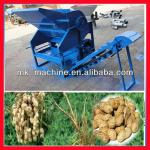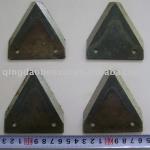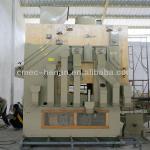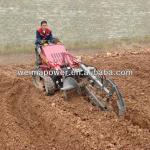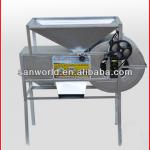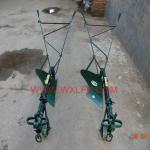soybean peanut etc. cooking oil continuous refining equipment from China
| Type:Oil Refining Equipment | Use:edible oil refining | Certification:ISO9001, BV, CE, etc.. | Place of Origin:Henan China (Mainland) |
| Brand Name:Qi'E | Model Number:soybean oil refining equipment | Condition:New | After-sales Service Provided:Engineers available to service machinery overseas |
| Color:silver | Material:carbon steel,stainless steel | Character:continuous | Advantage:low investment in high yield |
| Steam consumption:700KG/T oil | Electric consumption:28Kwh/T oil | Phosphoric acid:2~3 kg/T oil | Alkali:acid valuex1-3kg/T oil |
| Circulating water:150M3/H | Bleaching earth consumption:3-5Kg/T oil |
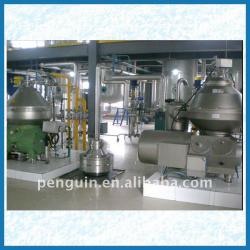
50-1000T/D Continuous Oil Refining EquipmentProcesses
1.Decolour tank is for bleaching grease.
2.Deodorizing tank is for desdorizing grease(stainless steel).
3.Conducting oil furnace provide thermal enery need for production, the temperature reach to 280degree.
4.Vacuum pump provides vacuum for bleaching, deodorization which can reach 755mmHg or more;
5.Air compreassor can dry the bleached clay
6.Air press is for filter clay
7.Steam generator can generate steam distillation required.
8.This kind of oil refining eqiupment make the oi reach the standard level national edible oil.
soybean oil refining equipment
50-1000T/D Continuous Oil Refining Equipment Features
1) For the continuous refining technology, our company has absorbed the advanced technology at home and abroad.
2) By combining several years' practical experience, adopting a kind of unique deguming technology, extending the phosphoric acid and oil reaction time and adding specific additives, our equipment can remove phospholipids in oil to the maximum.
3) The new carclazyte automatic quantitative system can produce more reliable oil of good quality, with less investment for the full vacuum closed refining technology.
4) We can design the optimum refining scheme according to different oils and different requirements for products.
| Steam consumption | 700KG/T oil |
| Electric consumption | 28Kwh/T oil |
| Water (soften water) | 150Kg/T oil |
| Phosphoric acid | 2~3 kg/T oil |
| Alkali | acid valuex1-3kg/T oil |
| Circulating water cooling water yield | 150M3/H |
| Bleaching earth consumption | 3-5Kg/T oil |
| Waste bleaching earth oil content | ≤25~35% |
| Refining losses | acid valuex1.2 (chemical refining) acid valuex 0.6 (physics refining) |
| Bleaching losses | the quantity of bleaching earth×0.25% |
| Deodorization loss consumption | ≤0.5%≤0.5% |
| Refining rate | 1-refining consumption |
Crude Palm Oil Refinery Equipment
Basing on the traditional oil refining technology, Zhengzhou QI'E Grain and Oil Machinery Co.,Ltd has developed the latest combined packing layer plate deodorization soft tower and the physical and chemical mixed refining technology for crude oil of any quality. Moreover, a series of advanced technology and equipment are used, such as super wet deguming, bleaching earth automatic metering, negative pressure decoloring, high vacuum steam jet deodorization, deacidification, winterization dewaxing etc.. With advanced technology, superior equipment, full-automatic control and excellent economic and technical parameters, our equipment can meet customers' different refinery equipments at home and abroad.
Continuous Oil Refining Process Introduction
Alkali hot water
Crude oil→filter→mix→reactor→mix→reactor→centrifugal separation→oil residue
↑ ↓
Phosphoric acid hot water→mix ↓
↓
degumming oil←cooler←dry←centrifuge separation←mix←alkali liquor
↓ ↓
↓ vacuum steam jet pump←steam citric acid
↓ ↓
bleaching earth→mix→decoloring→filter→decoloring oil→mix→heat
↓
refined oil←filter←cool←deodorizing←vacuum
Main Processes Introduction
Hydration Deguming & Alkali Refining Deacidification Process
Neutralization: the crude oil is output by the oil feed pump from the oil tank, and next enters the crude oil heat exchanger to recover part of heat after metering and then is heated to the required temperature by the heater. After that, the oil is mixed with the metered phosphoric acid or citric acid from phosphate tank in the gas mixture (M401), and then enters the conditioning tank (R401) to make the non-hydratable phospholipids in oil change into the hydratable phospholipids.Washing: there is still about 500ppm soap in the neutralized oil from the separator. To remove the remaining soap, add into the oil about 5~8% hot water, with water temperature 3~5 °C higher than the oil generally. To achieve more stable washing effect, add phosphoric acid or citric acid when washing. The re-mixed oil and water in the mixer is heated to 90-95°C by the heater, and then enters the wash separator to separate the remaining soap and most water.
Vacuum drying stage: there is still moisture in the oil from the wash separator, and the moisture will affect the stability of the oil. So the oil at 90°C should be sent to vacuum drier to remove the moisture, and then the dehydrated oil goes to the decoloring process. Finally, pump out the dry oil by canned pump.
Continuous Refining Decoloring Process
The main function of decoloring process is to remove oil pigment, residual soap grain and metal ions. Under negative pressure, the mechanical mixing method combined with steam mixing will improve the decoloring effect.
The degummed oil firstly enters into the heater to be heated to the appropriate temperature (110°C), and then goes to the bleaching earth mixing tank. The bleaching earth is delivered from the low bleaching box to the temporary tank by wind. The bleaching earth is added by automatic metering and is interlockingly controlled with the oil.
Continuous Decoloring Process Features:
1. The oil fully contacting with the decolorant can improve the decolorization efficiency and reduce the usage of decolorant;
2. The continuous and uniform material flows will balance the decoloring time and avoid the recovery of grease oxidation and acid value.
3. The special mixing structure of decoloring tower won't cause the material dead area, which can avoid the adsorbent sedimentation and pipe blockage.
4. The continuous airtight efficient filtration equipment has realized the automation of cake discharge and reduced the labor intensity.
5. The advanced drying technology can reduce the oil content in filter cake.
Continuous Refining Deodorizing Process
The qualified decolored oil enters into the spiral plate heat exchanger to recover most of the heat, and next goes to high pressure steam heat exchanger to be heated to the process temperature (240-260°C) and then enters the deodorization tower. The upper layer of combined deodorization tower is the packing structure which is mainly used to remove the odor producing components such as free fatty acid (FFA); the bottom layer is the plate tower which is mainly for achieving the hot decoloring effect and reducing the peroxide value of the oil to zero. Oil from the deodorization tower enters into the heat exchanger to recover most of the heat and makes further heat exchange with crude oil, and then is cooled to 80-85°C through the cooler. Add the required antioxidant and flavor agent, and then cool the oil below 50°C and store it. Such volatiles as FFA from the deodorizing system are separated by the packing catcher, and the separated liquid is FFA at low temperature (60-75°C). When the liquid level in the temporary tank is too high, the oil will be sent to the FFA storage tank.
Automatic Control System
Our company has applied the automatic control system with advancedness, security, reliability into the pretreatment, extraction, refining and fractionation in large oil plants. For its application in automatic control system, it can control the production in the entire workshop and monitor the operational status of each device by controlling the computer terminals in the room. One person only can operate the entire workshop, with efficient production management. It has reduced the production cost greatly and improved the management efficiency.

| Packaging Detail:International Export Standards, usually wooden box for soybean oil refining equipment |
| Delivery Detail:within 45-60 days for soybean oil refining equipment |









